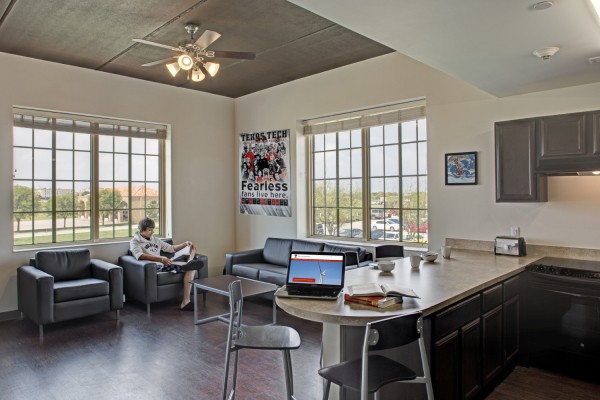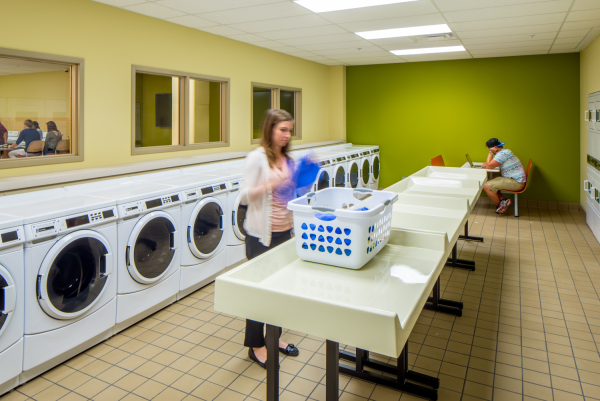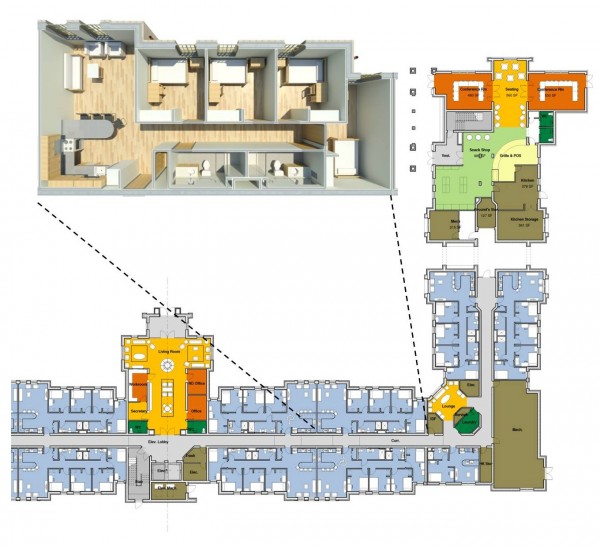In his previous post, firm president Steve Emer discussed the benefits of keeping upperclassmen on campus. In Part 2, he explains how these results can be achieved using architecture.
 Some Generalities Do Apply
Some Generalities Do Apply
The living environment shouldn’t feel like a “dorm” and should avoid an institutional feel.
Instead, consider a smaller, more intimate resident size (usually no more than 150) under one roof. Where demands are greater, it may be best to create a village of several smaller buildings instead of a singular large building.
Include a variety of apartment types, and even some variation among similar units. How many students will comfortably live together in the same apartment? Four is typical, sometimes six, and even unusual arrangements housing eight may work, particularly for international students. Look for ways to introduce unique characteristics… charm! Avoid predictable and numbing repetition. Variety will result in more interesting architectural massing. There is also a cost benefit to consider by introducing a small percentage of suite style or semi-suite units in the mix. Such a strategy will facilitate a population with some age diversity and encourage student mentorship.
Provide a variety of social spaces that support new relationships (opportunities for mentorship between older and younger students) in addition to established friendships. The inclusion of learning spaces may be desirable if the facility is remote from the academic core.
When asked, juniors and seniors generally state a preference for single bedrooms. But it is often prudent to include some doubles for those students who might actually want a roommate. This also offers a bit of financial flexibility. Single bedrooms can be on the small side if there are offsetting attributes (views, spacious living rooms and kitchens). Furniture types and sizes are a prime consideration (double bed or twin, closets or wardrobes, desk or easy chair with tablet arm…).
Laundry facilities can be much more than just a place to wash your clothes. Having washers and dryers in the unit may be appealing to residents, but the laundry area remains an important component of socialization and helps get students out of their apartment. Well-appointed and comfortable floor laundry rooms designed for socializing and group study shouldn’t be discounted.

The laundry facility at University of Minnesota’s 17th Street Residence Hall offers space for group study
Not all students want to cook for themselves at every meal. But the ability to cook for friends or roommates in their own kitchen on “special nights” is seen as an upperclassman privilege. It does take time to understand the prevailing student preferences on this subject, including such variables as proximity to campus dining venues, off campus grocery stores or even farmer’s markets. Perhaps the level of accommodation required within the unit is more basic (i.e. a sink, refrigerator, microwave and ample pantry storage for the number of occupants in the unit). If so, it will be necessary to include strategically located common kitchens that are capable of supporting more involved meal preparation.
Private bathrooms for each resident is typically cost prohibitive. A successful alternative is to compartmentalize plumbing fixtures in discrete zones to maximize flexibility of competing schedules and a sense of personal privacy. Include built-ins or floor area for adequate storage space for each resident’s toiletries.

Apartment-style units at Texas Tech University offer amenities to attract upperclassmen and compete with off-campus housing
Most importantly, consider the location of a proposed upperclassman residential facility in context with the rest of campus. If it is a remote site, make sure the connection to the heart of campus is strong through the use of consistent landscape features such as pathways, planting materials, lighting and the inclusion of comfortable and shady areas.
Programming and designing the outdoor spaces is equally as important as the interior spaces of the building. Avoid isolating upperclassmen in a perceived enclave of privilege.
Create a place where younger students also feel welcome. Include spaces that foster mentorship between students of all ages. Make a place that is special, memorable and desirable… a place where first and second year students long to live.

 By: Steve Emer
By: Steve Emer